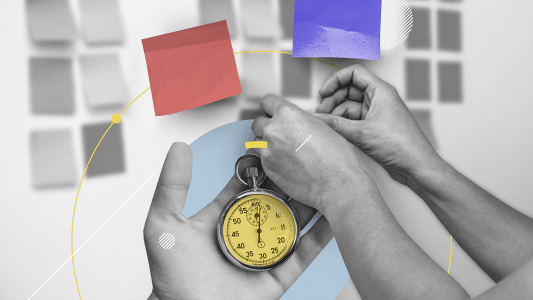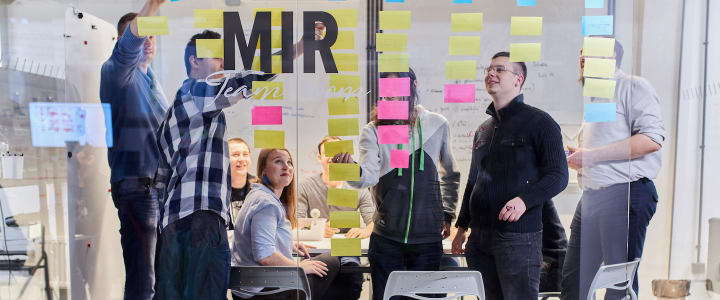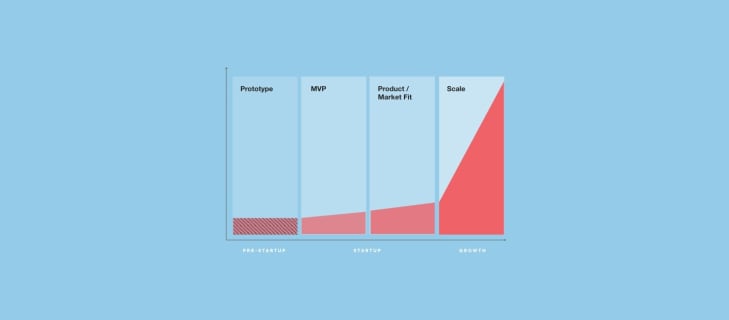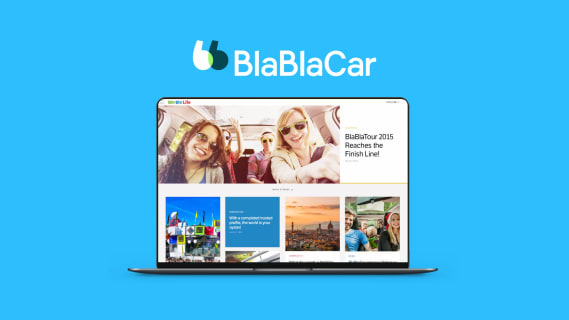How Lean Startup is different from Agile and Design Thinking
More than ever, businesses are focused on digital transformation, shifting access to their products and services online. This creates a need to invest in developing digital products – apps, websites, e-commerce platforms, etc. Whether you handle the development yourself or seek out an experienced development partner, the question isn’t just what to develop but also how. This article seeks to define and disentangle the approaches commonly used in digital product development: Agile, Design Thinking, and Lean Startup.
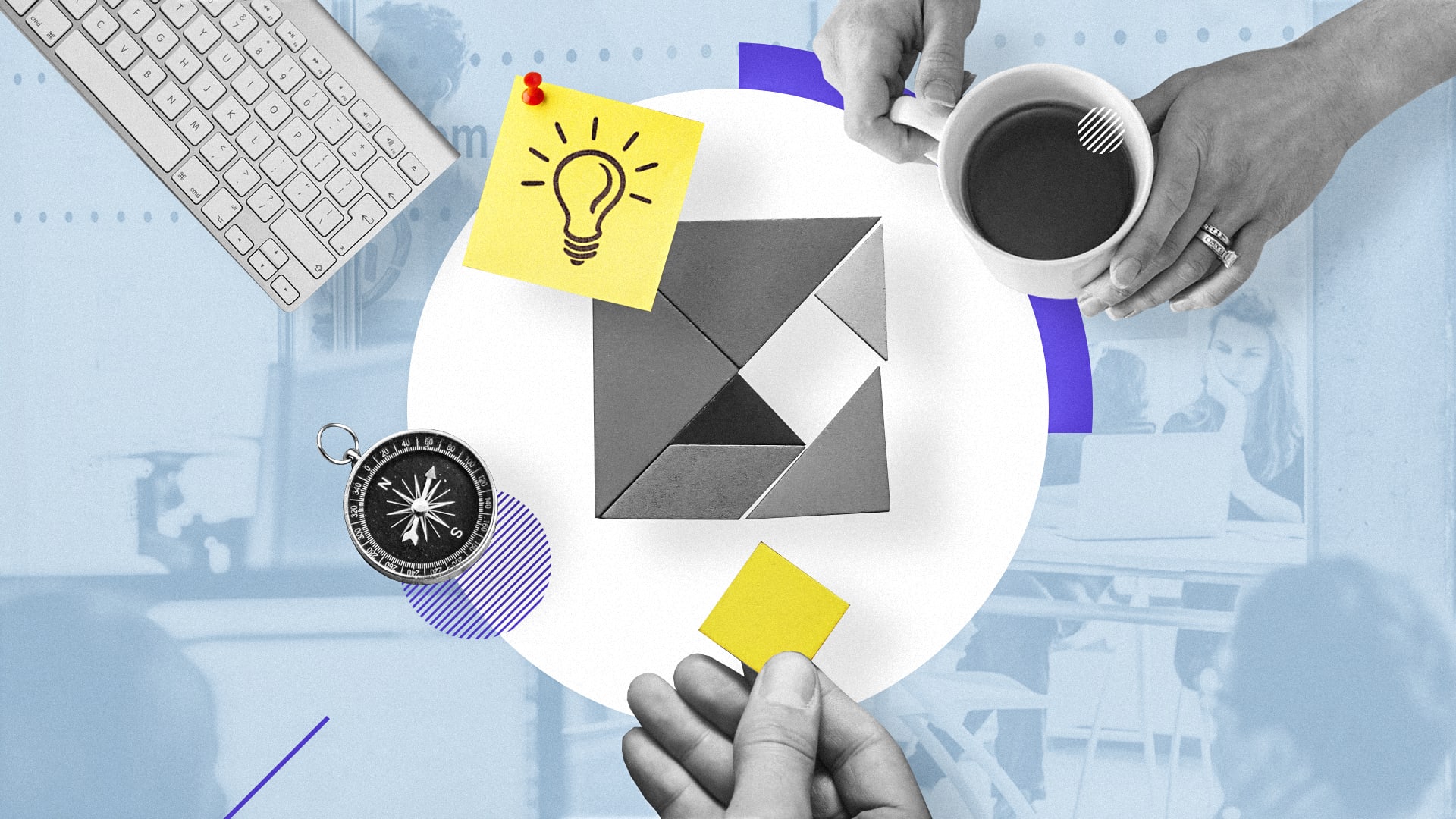
Table of contents
Have you ever been to a great restaurant, looked down the menu and been unable to make up your mind because it’s all so good? Or maybe you always order the same thing but are tempted by another dish – you’re just not sure it will satisfy you like your ‘usual’?
When you’re developing a digital product for your business but aren’t sure which methodology or approach is best, it can be a little like sitting in that restaurant, unsure what to order: Lean Startup (giving priority to testing and user feedback), Agile (creating a product in rapid, focused increments that enable easy scaling), or Design Thinking (with an emphasis on creating a diverse design team and a deep understanding of the digital product’s end user).
Design Thinking vs Agile vs Lean Startup
Building on our previous title, “What is the lean startup methodology?”, this article compares these three approaches to innovation, including how they might be combined.
Agile
The beginning of the 21st century saw the emergence of Agile as a response to the linear, traditional ‘waterfall’ approach to managing software projects (for more on the differences, check out our article, “Agile vs. Waterfall”). Whereas waterfall is all about planning, laying out a detailed project route map and sticking to it, Agile is, predictably, more agile with an emphasis on flexibility, client input, and breaking down the development process into bite-sized iterations.
There are a variety of Agile frameworks – e.g. Scrum, Kanban, etc. – but they all have the following characteristics:
- Work is carried out in short iterations, known as sprints.
- Teams are usually self-organized, cross-functional, and egalitarian.
- Communication is a key feature, usually based on regular team meetings (e.g. in the scrum framework, teams have a short meeting called a ‘daily scrum’ to review progress; scrum also offers other types of meetings that help drive the process, e.g. reviews and planning meetings).
- Product features or functions are released frequently.
A key element of Agile is flexibility, especially in terms of planning. The process is driven by a clear destination in the form of product vision and objectives (linked to business and user needs) but the route map to that destination can be rapidly adjusted to respond to changing circumstances. Part of this flexibility is the use of testing as a way to keep development on track, gather user feedback and input, and spot and eliminate any bugs; the result is faster development and minimized costs.
In Agile, transparency, especially in communication, is essential. This transparency depends partly on the tools used by the team (e.g. open Slack channels for communication) but also on the structure of the team itself. For example, at Boldare, we don’t have project managers. We use the agile scrum methodology and each team has a scrum master – not a manager, not a gatekeeper, but a facilitator who ensures the team is getting the most out of working in Agile.
Agile’s ultimate focus is on customer and user needs. Rather than build a whole product in one go, an agile team builds that product one function or feature at a time, checking alignment with user wants and needs at each stage. The result? A digital product that is fit for purpose and comes with built-in user commitment. To use our restaurant/menu analogy: Agile means a meal with lots of short courses, prepared quickly, and after each course you can change your order, with no penalty.
Design Thinking
Design Thinking is a process that focuses closely on the needs of the customer or client; i.e. the business goals you need the digital product to support, and the needs of your product users. Design Thinking uses a structured process to get to the heart of the client and user needs, truly understand them, and then apply innovation tools and techniques to come up with a creative (and highly appropriate) solution.
In a way, Design Thinking offers a consultancy approach to digital product design and development, codifying how a ‘designer-consultant’ would deal with a client’s project and enabling organizations and development partners of all sizes to effectively use that approach.
Though there are variations Stanford’s d.school offers a commonly-used five-step design thinking process:
- Empathy – get to know the client and their users; what’s the context, how do they think and feel about the problem?
- Definition – analyze the data to understand what users need, create insights into the issues underlying the problem, and define the problem people-centered terms.
- Ideation –challenge assumptions, storm ideas, give free rein to innovation, and design a solution to client and user needs.
- Prototyping – create a lo-fi, workable version of the solution that addresses at least part of the problem.
- Testing – test the prototype with users and gather feedback.
This can be a simple, linear sequence but it usually isn’t – new information and ideas often arise throughout the process and so stages are repeated, approached from different angles, and so on. The key is unlocking the team’s creativity and applying it directly to the heart of the problem or challenge.
Forrester-IBM research from a few years ago found that Design Thinking can reduce design and development time by up to 75%. What’s more, teams using Design Thinking tend to reduce development costs, improve risk management, and produce better quality products, and boost profitability.
The key to Design Thinking is the customer and user focus. The process may include collaboration, questioning, creativity, empathy, experimentation, and continuous improvement but the defining feature is it is user-centered. In our restaurant/menu analogy, the wait staff, chef and maître d’ are all keen to hear from you, not only about what you want to eat but why do you want it, what’s the occasion, what have you tried in the past, how do you hope this meal will make you feel…?
Lean Startup
The Lean Startup methodology is for more than just startups. Yes, it’s designed (and ideal) for new, entrepreneurial, innovative digital businesses but it also works for larger, more established businesses that want to address their need for a digital product. In common with Agile and Design Thinking, Lean Startup emphasizes the importance of the product’s end-user in a rigorous alternative to the classic project management approach. This alternative rests on five main principles:
- Entrepreneurs are everywhere – Which is not to say that Lean Startup is only for entrepreneurs but that an entrepreneurial attitude is adopted, looking to solve a common challenge in a new and unique way.
- Entrepreneurship is management – Lean Startup is about actively managing the development process; including making decisions about the process itself, and its goals and priorities in response to circumstances and feedback.
- Validated learning – Each idea, each feature, each function is treated as an experiment and is tested with potential users. Then their feedback is incorporated into the development process.
- Innovation accounting – The right metrics are important if you’re to accurately assess progress. In digital product development, traditional metrics (ROI, market share, etc.) are either less relevant or cannot be used. Instead, Lean Startup measures engagement with users, the project and product assumptions, and the product’s market fit.
- The Build-Measure-Learn cycle – Lean Startup is based on this basic cycle: build a prototype or MVP (i.e. a minimal version of the product, just one or two features), test it with potential users and gather feedback and data, then apply the conclusions and learning to the next version of the product. Rinse and repeat.
All of which highlights the importance of feedback in the Lean Startup approach. In fact, feedback from potential users and market is so important that without it, you’re not using Lean Startup – your process may have some lean features but Lean Startup is defined by feedback.
Ultimately, the Lean Startup approach is all about quickly and efficiently testing your business idea(s) in a practical way.
In our restaurant/menu analogy, the restaurant isn’t so important for Lean Startup – it’s more like a private venue, with your own private chef who, after each course, comes over and asks not only, How was your food? but also, How can I make it better in future?
Agile vs Design Thinking vs Lean - Mix and match?
The good thing about Lean Startup, Agile and Design Thinking is that they’re not mutually exclusive. Fare from it. Depending on the digital product you’re looking to develop, you can use elements of each, or all three. To see how, let’s focus on the differences and how they might fit together:
Design Thinking
- A highly investigative approach to exploring the problem/challenge that the product is intended to solve.
- Focused on the client and user goals and needs.
- Ideation to come up with innovative solutions.
Lean Startup
- A structured approach to turning ideas into business models.
- Rigorous testing of solutions and features.
Agile
- Building the product… and later, scaling the product.
- Use of time-limited increments to develop and test product features and iterations.
- Built-in flexibility allows you to change features and even product goals, if necessary.
So - Lean Startup vs Agile vs Design Thinking? They’re all proven approaches to digital innovation, separately or in combination, and can be used together to produce high quality digital products rapidly and efficiently. All three include a strong focus on the product’s end-user and include the use of concrete feedback to guide the development process, rather than theory or wishful thinking. Used together, Design Thinking can be used to explore the problem or challenge, and to come up with innovative ideas as solutions; Lean Startup can be used to test these ideas and solutions and identify the ‘right’ product; and Agile offers a structured-yet-flexible process for building that product.
To return to our restaurant/menu analogy, the reality is that all the dishes (approaches) are good, and taken together can even form a process that gives you the whole ‘meal’ – from soup to nuts, as the saying goes.
Share this article:

